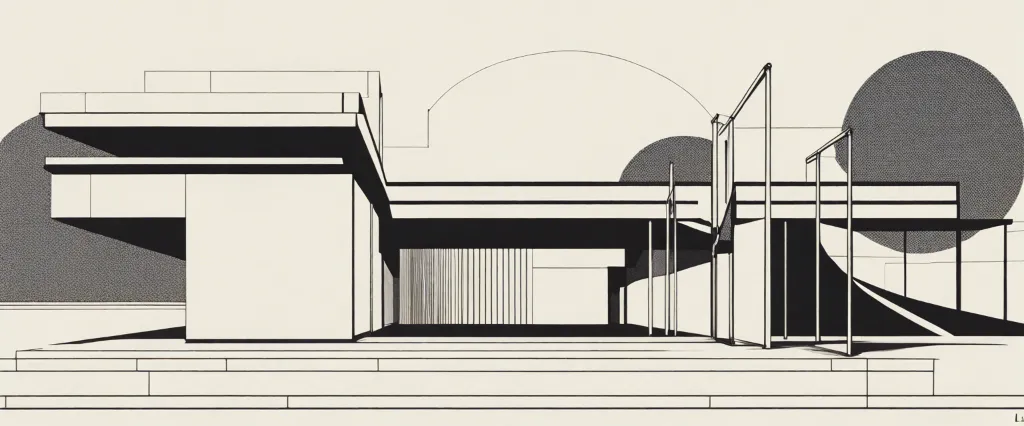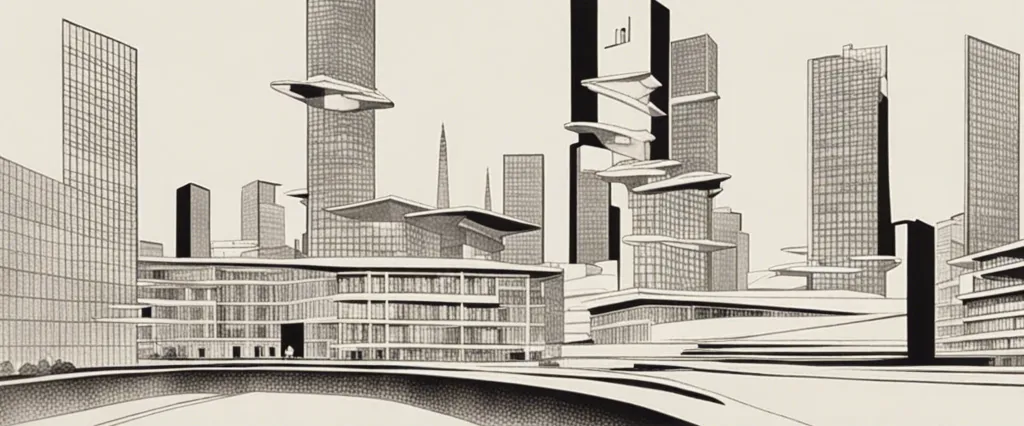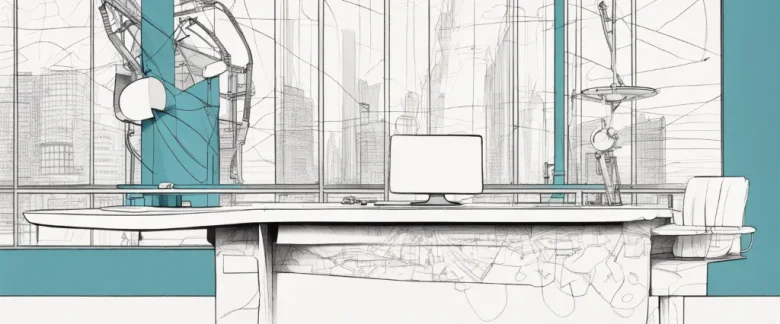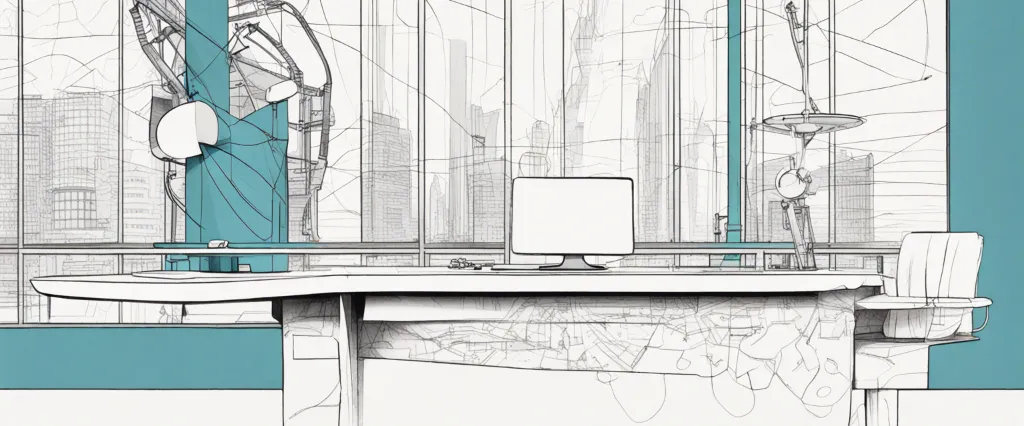In “Towards a New Architecture,” Le Corbusier, also known as Charles-Édouard Jeanneret-Gris, presents his groundbreaking manifesto on modern architecture. Published in 1923, this influential book criticizes the decorative and ornamental aspects of architectural tradition, advocating for a functional, rational, and minimalist approach to design. Le Corbusier, a Swiss-French architect, urban planner, and artist, played a crucial role in shaping the 20th-century architectural discourse, leaving an indelible mark on modernist movement with his innovative ideas and radical designs. With “Towards a New Architecture,” Le Corbusier embarks on a visionary exploration of the principles and techniques that must lay the foundation for a progressive and efficient architectural language.
Introduction to Modern Architecture
Towards a New Architecture, written by the renowned architect Le Corbusier, explores the concept of modern architecture and presents a radical viewpoint on the subject. The book consists of a series of essays and illustrations, offering a comprehensive overview of his architectural philosophy.
In the chapter titled “Introduction to Modern Architecture,” Le Corbusier challenges traditional architectural principles and calls for a fresh approach that aligns with the industrial age. He criticizes the prevalent architectural practices of his time, considering them to be outdated and ineffective. According to Le Corbusier, architecture should be in sync with societal and technological advancements, reflecting the needs of the modern era.
Le Corbusier emphasizes the importance of functionality and efficiency in architecture. He proposes the idea of the “house as a machine,” where buildings should be designed to serve their occupants seamlessly, providing all necessary amenities and promoting comfort. He emphasizes the need for flexible and adaptable spaces that can cater to changing needs over time.
Furthermore, Le Corbusier highlights the significance of open spaces and natural light in architectural design. He argues that buildings should embrace the surrounding environment and offer a sense of harmony between nature and human habitat. This concept is exemplified through his famous “Five Points of Architecture,” which include pilotis (columns), free facade, open floor plan, horizontal windows, and roof garden.
In summary, Le Corbusier’s “Introduction to Modern Architecture” challenges conventional architectural practices and introduces an innovative approach that caters to the industrial age. With a focus on functionality, efficiency, and harmony with nature, Le Corbusier presents a vision for a modern architecture that aligns with the needs and aspirations of the contemporary world.
The Engineer’s Aesthetic
Towards a New Architecture by Le Corbusier is a seminal book that outlines the architect’s vision for a modern and functional architecture. In it, Le Corbusier presents his influential concept of The Engineer’s Aesthetic, which aims to revolutionize the way buildings are designed and constructed.
According to Le Corbusier, The Engineer’s Aesthetic is rooted in the principles of efficiency, functionality, and rationality. He argues that architects should approach their craft like engineers, prioritizing practicality and rejecting unnecessary ornamentation. Instead of being tied to traditional styles and historical references, architecture should be responsive to the needs of modern society and embrace new materials and technologies.
One key aspect of The Engineer’s Aesthetic is the concept of the “Five Points of a New Architecture.” Le Corbusier proposes five principles that he believes are essential for creating functional and efficient buildings. These include: the use of pilotis (columns) to lift the building off the ground, an open plan interior, horizontal windows to ensure proper lighting and ventilation, a free facade (unconstrained by load-bearing walls), and a roof garden to reclaim green spaces lost to urbanization.
Le Corbusier also emphasizes the importance of mass production and standardization in architecture, comparing buildings to machines. He advocates for the use of prefabricated components that can be easily assembled on-site, making construction more efficient and cost-effective.
Overall, Le Corbusier’s The Engineer’s Aesthetic presents a radical departure from traditional architectural styles, promoting a modernist vision that is functional, efficient, and responsive to the needs of the contemporary world. It continues to inspire architects and designers to this day, shaping the way we think about modern architecture.
The Five Points of Architecture
The Five Points of Architecture, outlined by Le Corbusier in his book Towards a New Architecture, revolutionized modern architectural theory and practice. These five points were put forth as principles that would respond to the needs of contemporary society and technology. This summary will provide an overview of these points and their significance.
The first point, called pilotis, refers to the use of reinforced concrete columns to lift the building off the ground. By doing so, the ground beneath becomes free-flowing and available for circulation, while the building gains a feeling of lightness and openness.
The second point is the free plan, which liberates the interior from load-bearing walls. This allows for flexible and adaptable spaces that can be reconfigured according to changing needs. The idea is to create an open and functional interior without any unnecessary walls or partitions.
The third point is the free facade, where the facade is no longer tied to the structural system of the building. This allows for more freedom in the design of the exterior, enabling architects to experiment with various materials and create visually appealing facades.
The fourth point is horizontal windows, which use ribbon-like bands of windows to provide equal distribution of natural light across the interior. This creates a sense of openness and connection with the outside, while also facilitating cross-ventilation.
The fifth and final point is the roof garden, which is essentially the extension of the building footprint into outdoor space. It promotes the idea of incorporating nature into architecture and allows for various recreational activities, as well as providing insulation and environmental benefits.
Le Corbusier’s Five Points of Architecture were groundbreaking at the time and have had a significant influence on modern architecture. They emphasize functionality, efficiency, and integration with the surrounding environment. These points challenged traditional architectural conventions and laid the foundation for a new way of thinking about design.
The Plan and the House

“Towards a New Architecture” by Le Corbusier, a pioneering modernist architect, presents a radical manifesto that seeks to redefine architecture and its relationship with society. The book can be divided into two main parts: “The Plan” and “The House.”
In “The Plan,” Le Corbusier argues for a fundamental shift in urban planning. He critiques the chaotic and inefficient urban environments of the early 20th century, advocating for the implementation of functional and rational urban plans. He proposes principles such as replacing narrow and congested streets with wide, open boulevards and separating traffic flow from pedestrian areas. Le Corbusier also champions the idea of zoning, with designated areas for residential, industrial, and recreational purposes. The overall aim of his plan is to create harmonious and efficient cities that prioritize function and movement while improving the quality of life for its inhabitants.
On the other hand, in “The House,” Le Corbusier focuses on the design of individual dwellings. He expresses his dissatisfaction with traditional architectural styles and suggests embracing the use of raw materials such as concrete and steel to create minimalist and functional living spaces. He emphasizes the importance of crediting the house as a machine for living, where every element has a specific purpose and contributes to the overall comfort and efficiency of the inhabitants. Furthermore, Le Corbusier reinforces the significance of open floor plans, natural light, and the integration of technology to enhance modern living conditions.
Overall, “Towards a New Architecture” advocates for a complete revolution in architectural principles, grounded in the pursuit of functionality, efficiency, and human well-being. Through the bold reinterpretation of urban planning and house design, Le Corbusier aims to create a new architectural language that aligns with the needs and aspirations of the modern world.
The City of Tomorrow
Le Corbusier’s book Towards a New Architecture presents his visionary ideas for the future of urban planning and architecture. One of the key concepts discussed is “The City of Tomorrow,” where he envisions a radical transformation of cities to meet the needs of the modern society in the 20th century.
According to Le Corbusier, the current urban fabric is congested, chaotic, and outdated. In order to create a better urban environment, he proposes the demolition of existing dilapidated buildings and the construction of high-rise buildings that can accommodate a larger population and promote efficient land use. Le Corbusier argues that tall buildings spread out over large areas would eliminate overcrowding, improve circulation, and offer better living conditions.
In addition to vertical development, Le Corbusier suggests the creation of green spaces within cities. He advocates for the implementation of large parks and gardens, as well as the integration of nature into urban landscapes. These open green spaces are not only aesthetically pleasing but also serve as areas for relaxation, recreation, and physical activities, which are crucial for the health and wellbeing of city dwellers.
Furthermore, Le Corbusier emphasizes the need for efficient transportation systems in his vision of The City of Tomorrow. He suggests the construction of elevated highways, known as “The Vertical,” which would separate pedestrian and vehicular traffic, reducing congestion and increasing safety. He also promotes the idea of rooftop airports to connect cities globally and further improve transportation accessibility.
In summary, Le Corbusier’s concept of The City of Tomorrow promotes vertical development, incorporating large green spaces, and efficient transportation systems. His ideas aim to create a harmonious and functional urban environment that caters to the needs of the modern society, fostering a better quality of life for its inhabitants.
The Decorative Art of Today
In the book “Towards a New Architecture” by Le Corbusier, he criticizes the excessive use of decorative art in buildings and advocates for a more simplistic and functional approach to design. His chapter titled “The Decorative Art of Today” delves into the issue of decorative art and its role in architecture.
Le Corbusier begins by stating that the decorative art of today has lost its true purpose and has become more of a superficial addition to buildings, rather than serving any functional purpose. He argues that architects should prioritize the essential needs of human habitation and the structural integrity of a building over excessive ornamentation.
He argues that the burden of excessive decoration detracts from the purity of the architectural form and the expression of its true purpose. According to Le Corbusier, modern architecture should focus on the honest use of materials and the expression of function and purpose, rather than using decoration as a means to mask or distract from the lack of substance.
Le Corbusier believes in the importance of functionality and rationality in architecture. He advocates for the use of standardized components and industrial processes in building construction to increase efficiency and reduce costs. By eliminating unnecessary decorative elements, Le Corbusier believes that buildings can become more affordable and accessible to a wider population.
In summary, Le Corbusier’s chapter on “The Decorative Art of Today” criticizes the excessive use of decorative art in architecture. He argues that architecture should prioritize functionality, rationality, and honesty in design, rather than relying on decoration as a superfluous addition. Le Corbusier’s ideas aim to create more economical and efficient buildings that serve the true needs of human habitation.
The Engineer’s Task
Towards a New Architecture by Le Corbusier is a seminal book that discusses the radical ideas regarding architecture and the role of engineers in shaping the modern world. The engineer’s task, as portrayed by Le Corbusier, is a critical element in this transformative process.
In the book, Le Corbusier argues for a departure from traditional architectural practices and the adoption of a more functional and efficient approach. He critiques the excessive ornamentation and superficial beauty that characterized much of the existing architectural styles of his time. Instead, he advocates for a focus on the needs of the inhabitants and the efficient utilization of space, materials, and technology.
According to Le Corbusier, the engineer has a crucial role to play in realizing this vision. He emphasizes the importance of collaboration between architects and engineers in order to achieve the desired outcome. Engineers are expected to bring their technical expertise to ensure the structural integrity and efficient construction of buildings. They are also responsible for incorporating innovative technologies and materials to create functional and aesthetically pleasing spaces.
Furthermore, Le Corbusier highlights the need for engineers to embrace modernism and reject the traditional approach. He argues that the development of new architectural forms and styles can only be achieved through a deep understanding of scientific and technological advancements.
Overall, Le Corbusier’s book Towards a New Architecture presents a radical perspective on architecture, urging engineers to embrace modernism and utilize their technical knowledge to create functional and efficient spaces that meet the needs of the inhabitants.

Conclusion: Architecture or Revolution
In the book “Towards a New Architecture” by Le Corbusier, the Conclusion: Architecture or Revolution serves as the culminating chapter that encapsulates the architect’s vision for the future of architecture and its potential impact on society. In this thought-provoking conclusion, Le Corbusier emphasizes the need for a revolution in architectural principles and practices.
Le Corbusier argues that architecture should not be a mere artistic pursuit or a means of mere construction but a tool to address the urgent social and economic issues of the time. He believes that architecture holds the potential to shape a better future by providing efficient solutions for housing, urban planning, and the utilization of space. Le Corbusier criticizes traditional architecture for being trapped in historical styles and failing to adapt to the changing needs of society.
The architect advocates for a new approach that embraces modern technology, industrialization, and contemporary materials. He emphasizes the importance of functionality and efficiency in design, rejecting ornamentation and excess in favor of simplicity and functionality. Le Corbusier specifically advocates for the use of the five points of architecture: pilotis, a roof garden, an open floor plan, horizontal windows, and free design of facades. These principles aim to create flexible, airy, and functional spaces that could enhance the quality of life for inhabitants.
Le Corbusier further calls for urban planning that promotes green spaces, efficient transportation systems, and the harmonious integration of buildings into their surroundings. He envisions a future where architecture is a catalyst for social progress, promoting equality, health, and well-being for all.
Overall, the conclusion of “Towards a New Architecture” reflects Le Corbusier’s revolutionary spirit and his belief in the transformative power of architecture to solve society’s pressing issues. His ideas continue to influence architects and urban planners, highlighting the lasting importance of his vision.
After Reading
In conclusion, “Towards a New Architecture” by Le Corbusier offers a groundbreaking perspective on architecture and design. Through his visionary ideas and bold proposals, Le Corbusier advocates for a new approach that embraces modern technology, functionalism, and the need to create spaces that cater to the demands of the industrial age. Throughout the book, he emphasizes the significance of the human element in architecture, while also critiquing traditional styles and addressing the challenges and opportunities that arise with urban growth. With his unique blend of theory, practicality, and artistic sensibility, Le Corbusier’s work continues to inspire and shape the world of architecture even today.
1. “The Fountainhead” by Ayn Rand – This classic novel explores the relationship between architecture and individualism. It tells the story of an ambitious architect who battles against conformity and mediocrity in the pursuit of his vision.
2. The Architecture of Happiness” by Alain de Botton – In this thought-provoking book, de Botton explores the connection between our surroundings and our well-being. He discusses how art and architecture impact our emotions and offers insights into how design can enhance our lives.
3. “Delirious New York: A Retroactive Manifesto for Manhattan” by Rem Koolhaas – Koolhaas examines the chaotic and dynamic nature of New York City, delving into its architectural history and examining its impact on the urban life. This book offers a unique perspective on architecture’s role in shaping the identity of a city.
4. The Death and Life of Great American Cities” by Jane Jacobs – Jacobs challenges traditional urban planning ideas in this influential book. She argues for a bottom-up approach to urban design and emphasizes the importance of diverse neighborhoods and pedestrian-friendly streets.
5. “S, M, L, XL” by Rem Koolhaas and Bruce Mau – This comprehensive and visually stunning book is a compilation of Koolhaas’ projects and writings. It explores the complexities of modern architecture, urbanism, and design, offering a unique insight into the mind of one of the most influential architects of our time.




